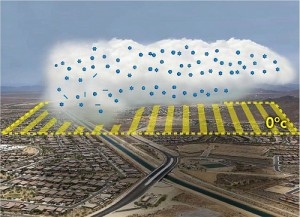Air pollution can cause larger storm clouds, study finds
Aerosol particles can cause thunderstorm clouds to linger for longer and increase the temperature at night, US scientific study finds
Air pollution in the form of aerosol particles can cause thunderstorms to leave behind larger and longer-lasting storm clouds, according to a scientific study.
The research findings, which appeared in the Proceedings of the National Academy of Sciences this week (November 26), showed that aerosol particles can make clouds linger by decreasing the size and increasing the lifespan of cloud and ice particles.

Scientists found that air pollution decreases the size of cloud and ice particles and increases their lifespans, making clouds grow bigger (Picture: Pacific Northwest National Laboratory)
Furthermore, aerosol particles can decrease the daily temperature range through storm clouds, as after a thunderstorm these clouds spread out across the sky to ‘look like anvils’. During the day these clouds cool the earth with their shadows but trap heat during the night.
Thus, pollution can cause clouds from later afternoon thunderstorms to last longer into the night instead of dissipating, causing warmer nights.
There are greater numbers of manmade aerosol liquid or solid particles — which can include haze, dust, particulate matter and smoke — in polluted skies, the study states.
The research — carried out by a team led by scientists from the US department of energy’s Pacific Northwest National Laboratory — is based on modelling of cloud data from the western pacific, south eastern China and Oklahoma.
Until now, the researchers claim, it was thought that air pollution caused larger and longer-lasting storm clouds through a process known as convection.
However, stronger convection has not always been seen by scientists every time larger and longer-lasting clouds in polluted environments are analysed, suggesting that stronger convection was not the reason.
This is because, according to lead scientist Jiwen Fan, poor reconstructions in the past have not provided a full picture of the process.
The scientist said: “This study reconciles what we see in real life to what computer models show us. Observations consistently show taller and bigger anvil-shaped clouds in storm systems with pollution, but the models don’t always show stronger convection. Now we know why.”
She added: “Modelling the details of cloud microphysical properties is very computationally intensive, so models don’t usually include them.”
The work was supported by the US department of energy’s office of science using data collected by the department’s climate research facility.







 Network
Network